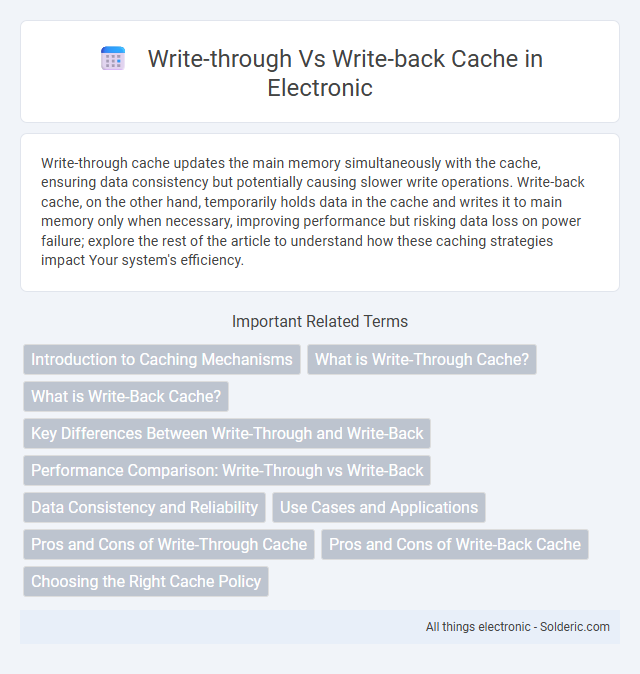Write-through cache updates the main memory simultaneously with the cache, ensuring data consistency but potentially causing slower write operations. Write-back cache, on the other hand, temporarily holds data in the cache and writes it to main memory only when necessary, improving performance but risking data loss on power failure; explore the rest of the article to understand how these caching strategies impact Your system's efficiency.
Comparison Table
| Feature | Write-Through Cache | Write-Back Cache |
|---|---|---|
| Definition | Data written to cache and main memory simultaneously. | Data written only to cache initially; main memory updated later. |
| Write Latency | Higher latency due to immediate memory writes. | Lower latency by deferring memory writes. |
| Data Consistency | Maintains strong consistency between cache and memory. | Potential data inconsistency until write-back occurs. |
| Complexity | Simple implementation. | More complex due to tracking dirty blocks. |
| Use Case | Systems prioritizing data integrity and consistency. | Systems optimizing performance and write efficiency. |
| Power Consumption | Higher, due to frequent memory writes. | Lower, fewer writes to main memory. |
| Risk of Data Loss | Lower risk in case of power failure. | Higher risk if cache is not flushed properly. |
Introduction to Caching Mechanisms
Write-through cache immediately updates both the cache and the main memory with every write operation, ensuring data consistency but potentially reducing performance. Write-back cache, however, only updates the cache initially and writes data back to the main memory later, improving speed but requiring more complex coherence management. Understanding these caching mechanisms helps you optimize system performance and data integrity based on workload requirements.
What is Write-Through Cache?
Write-through cache is a caching technique where data is simultaneously written to both the cache and the main memory, ensuring data consistency between them. It minimizes the risk of data loss in case of a cache failure by immediately updating the main memory with every write operation. This approach is commonly used in systems requiring high data reliability and integrity, despite potentially higher latency compared to write-back cache.
What is Write-Back Cache?
Write-back cache is a memory caching technique where data is written to the cache first and only updated in the main memory when the cache block is replaced or modified. This method reduces the number of write operations to the slower main memory, improving system performance and efficiency. Understanding write-back cache helps you optimize data storage and retrieval in high-speed computing environments.
Key Differences Between Write-Through and Write-Back
Write-through cache immediately updates both the cache and main memory during data writes, ensuring data consistency but causing higher latency. Write-back cache postpones writing data to main memory until the cache line is replaced, improving write performance with a risk of data loss during a system failure. Write-through offers simplicity and reliability, whereas write-back provides better performance at the cost of complexity and potential data coherence issues.
Performance Comparison: Write-Through vs Write-Back
Write-back cache typically offers superior performance compared to write-through cache by reducing the number of write operations to the slower main memory, as data changes are stored in the cache and written back only when necessary. Write-through cache ensures data consistency by immediately updating main memory with each write, but this can result in higher latency and reduced system throughput. Understanding your system's workload can help you choose the optimal caching strategy to balance performance and data integrity.
Data Consistency and Reliability
Write-through cache guarantees data consistency by immediately writing data to both the cache and main memory, ensuring reliability but incurring higher latency. Write-back cache improves performance by delaying writes until data is evicted from the cache, but this approach risks data loss or inconsistency during power failures or system crashes. Your choice depends on whether data reliability or system performance is the priority in your computing environment.
Use Cases and Applications
Write-through cache is ideal for systems requiring high data integrity and consistency, such as financial transactions and real-time database environments, where every write operation must be immediately reflected in main memory. Write-back cache suits high-performance computing and gaming applications where speed is critical, as it reduces memory write latency by temporarily storing data before committing it to main memory. Understanding your workload's tolerance for latency and data coherence helps you choose the appropriate cache write policy to optimize performance and reliability.
Pros and Cons of Write-Through Cache
Write-through cache ensures data consistency by immediately updating both the cache and main memory, providing reliable data integrity for your system. It eliminates the risk of data loss during power failures but may cause slower write performance due to continuous memory updates. This method simplifies cache design and debugging but can increase memory bandwidth usage compared to write-back cache.
Pros and Cons of Write-Back Cache
Write-back cache improves system performance by reducing write latency, as data is only written to the main memory when it is evicted from the cache, minimizing memory bandwidth usage. However, the risk of data loss or corruption increases during a power failure or system crash because modified data may not be immediately saved to the main memory. Your decision to use write-back cache should balance performance gains against potential data integrity issues in critical applications.
Choosing the Right Cache Policy
Choosing the right cache policy between write-through and write-back depends on the balance between data integrity and system performance. Write-through cache ensures reliability by immediately updating main memory upon every write, reducing the risk of data loss but potentially causing higher latency. Write-back cache enhances performance by delaying main memory updates until the cache line is replaced, making it suitable for systems prioritizing speed and tolerating some risk of data inconsistency during power failures.
write-through vs write-back cache Infographic

 solderic.com
solderic.com